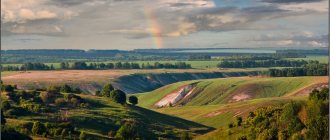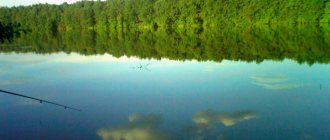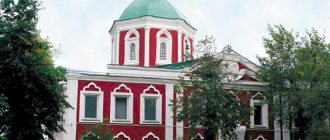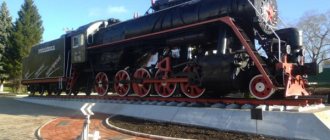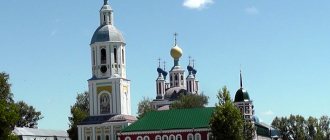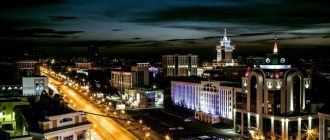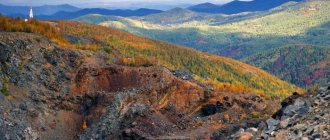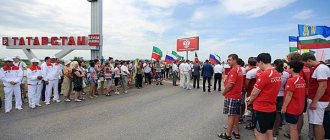The Republic of Mordovia
(m., e.
Mordovia Respublikas
),
Mordovia
(m., e.
Mordoviyas
),
RM
is a republic (state), an equal subject of the Russian Federation. The capital is Saransk (339.5 thousand people, as of January 1, 2002). The population of the Republic of Moldova is 910 thousand people. (as of January 1, 2002). The official languages are Russian and Mordovian languages (Moksha and Erzya).
The Republic of Mordovia is located in the central part of the East European (Russian) Plain, between the Oka and Sura rivers. The area of the Republic of Moldova is 26.1 thousand km². The length from west to east is about 280 km, from north to south – from 55 to 140 km (coordinates 53° 40′ and 55° 15′ N, 42° 12′ and 46° 43′ E) . It borders: in the west - with Ryazan, in the north - with Nizhny Novgorod, in the east - with Ulyanovsk, in the south - with Penza regions, in the northeast - with the Chuvash Republic. The distance from Moscow to Saransk is 642 km. Part of the Volga Federal District.
The Republic of Mordovia is part of a densely populated and well-developed zone of the Russian Federation. The most important railway, pipeline and highway routes pass through the territory of the republic, connecting the European part of Russia with the Urals, and the north with the Volga region. A developed national economic complex with diversified industry and agriculture has been created.
[edit] Government system
The Republic of Mordovia has on its territory all the fullness of state power, with the exception of powers assigned in accordance with the Constitution of Russia to the jurisdiction of the Russian Federation, as well as those that are the subject of joint jurisdiction of the Russian Federation and the Republic of Mordovia in accordance with the Constitution of Russia and the Constitution of the Republic of Mordovia (see Constitutional and legal status Republic of Mordovia).
State power in the Republic of Moldova is exercised on the basis of division into legislative, executive and judicial. The system of government bodies of the Republic of Moldova includes:
- The Head of the Republic of Mordovia is the highest official elected on the basis of universal, equal and direct suffrage by secret ballot for a period of 5 years. Heads the Government of the Republic of Moldova, in agreement with the State Assembly of the Republic of Moldova, appoints the Chairman of the Government, approves its structure;
- The State Assembly of the Republic of Moldova (unicameral) is the highest legislative (representative) body of state power of the Republic of Moldova, elected for 4 years. His jurisdiction includes introducing amendments to the Constitution of the Republic of Moldova, implementing legislative initiatives in the State Duma of the Federal Assembly of the Russian Federation, monitoring the implementation of the legislation of the Russian Federation and the Republic of Moldova, as well as the budget of the Republic of Moldova, exercising other powers assigned by the Constitution of the Republic of Moldova and the laws of the Republic of Moldova;
- The Government of the Republic of Mordovia is the permanent highest executive body of the Republic of Moldova, formed and headed by the Head of the Republic of Moldova, accountable to the State Assembly of the Republic of Moldova. Consists of the chairman, deputy chairman, ministers and other heads of executive bodies of state power of the Republic of Moldova. Develops the budget of the republic and ensures its execution; develops programs for the socio-economic development of the Republic of Moldova; carries out management of the property of the Republic of Moldova and other powers assigned to it by the Constitution of the Republic of Moldova, federal laws, laws of the Republic of Moldova and other regulatory legal acts of the Russian Federation;
- The judicial system of the Republic of Moldova is a link in the unified judicial system of the Russian Federation. Established by the Constitution of the Russian Federation, federal laws, the Constitution of the Republic of Moldova and the laws of the Republic of Moldova.
In cities, towns, rural settlements and other territories of the Republic of Moldova, management is carried out by local government bodies. Local self-government is implemented through various forms of expression of the will of the population (referendums, meetings, gatherings, etc.), elected and other self-government bodies; ensures that the population independently resolves issues of local importance and manages municipal property.
The Republic of Mordovia has its own state symbols: coat of arms, anthem and flag.
In accordance with the Constitution of the Russian Federation and federal laws, territorial structures of federal government bodies operate on the territory of the Republic of Moldova. Coordination of their activities to implement the policy of the President of the Russian Federation in the republic is ensured by the plenipotentiary representative of the President of the Russian Federation in the Volga Federal District and the Chief Federal Inspector for the Republic of Mordovia appointed by him.
Saransk urban district
Saransk is the capital of the Republic of Mordovia, a political, economic, scientific and cultural center. Territory 71.5 km2. The population of the city is 297.4 thousand people. (2010), Saransk urban district - 324.9 thousand people. (2010).
Saransk is located in the forest-steppe landscapes of the central part of the Insar basin. The geological environment in the city consists of Carboniferous (limestones and dolomites with interlayers of anhydrites, clays, mudstones and marls), Jurassic (clays, clayey sands with interlayers and lenses of sandstones, siltstones), Cretaceous (sandy clays, siltstones, siltstones, sands, sandstones, opoka) and Quaternary deposits.
The main residential and industrial zones are located in the altitude range of 125–200 m. In watershed areas, absolute heights reach 250 m. In local areas along the bedrock sides of river valleys and steep slopes, landslide formation and flooding occur.
The climate is moderate continental. The average temperature of the coldest month (January) is –12.3 °C, with a decrease to – 44 °C. The average temperature of the warmest month (July) is +19.2 °C, extreme values reach +39 °C. The average annual precipitation is about 500 mm. Deviation towards minimum and maximum values up to 180 mm.
The catchment area of the Insar River at the Saransk site is 1,610 km2; the average long-term annual flow is 7.89 m3/s, the volume is 249 million m3 per year. On the territory of the city, the Tavla and Saranka rivers flow into Insar.
The main exploited aquifer is located in cavernous-fractured limestones and dolomites of the Middle and Upper Carboniferous. The city's water supply system is based on the Saransk city section, as well as the water intakes of the SRK, Penzyatsky and Rudninsky.
The general pattern of landscape differentiation of the urban district of Saransk is the slope change of geocomplexes. Dark gray forest soils predominate in gently undulating watershed areas composed of eluvial-deluvial deposits of terrigenous rocks. On the lower sections of the slopes and in the Insar valley, under meadow steppes, podzolized, leached and meadow chernozems are common on the colluvium of terrigenous rocks. In the suburbs of Saransk, secondary deciduous forests predominate, mainly oak and aspen forests.
The ecological framework of the city is supported by the structure of green spaces. The main water-green corridors stretch along the floodplains of the Insar, Saranka and Tavla rivers, connecting suburban forested areas. They are important elements of the landscape and recreational complex.
There are different points of view on the origin of the name of Saransk: the name-hydronym is ancient Mordov. сap – “branch, fork, fork; influx"; the name-characteristic given by the area is sara in the Finno-Ugric languages - “swampy, muddy place.”
Saransk was founded in 1641 as a fort on the Atemar zasechnaya line, on the high left bank of the river. Saranka, not far from its confluence with the river. Insar. In 1655, the ancestor of the great Russian poet M. Yu. Lermontov, Peter Lermont, was the governor of Saransk. With the loss of military significance, Saransk turned into a trade and craft city, the administrative center of the Saransk district (1651). In the 2nd volume of the publication “Russia. A complete geographical description of our fatherland,” published at the turn of the 19th and 20th centuries, states that Saransk is the best of the cities in the province: “... it is quite extensive and has three areas; Of these, Sobornaya forms the city center. In ancient times, an earthen rampart ran along it, the remains of which are now visible only at the end of the city. Nowadays on Cathedral Square there is a monastery and 4 churches, a government building, a magistrate’s office, a prison castle and stone benches...” Further about.
The socio-economic development of Saransk accelerated the construction of the railway in 1893. At the turn of the 19th–20th centuries. The development of other infrastructure elements is also intensifying, a power plant, post office, telegraph, telephone exchange, printing house, hospitals, pharmacies, libraries, cinema, etc. are functioning. The Saransk School of Painting and the Saransk Society of Lovers of Fine Arts operate in the city.
Steady population growth in Saransk was observed until the early 1990s.
Currently, the urban district of Saransk accounts for about 40% of the population living in the republic, including 60% urban and 2% rural; 35% of the economically active population; 38% of the total number of workers and employees employed in the national economy; 65% of total industrial production; 40% of housing commissioning.
Social infrastructure. In the historical part of Saransk, a representative center with administrative and public buildings, often built according to individual projects, was formed. New buildings attract attention - theaters, stadiums, bank buildings, luxury residential buildings. They add variety to the urban environment. In addition to the center, there are residential microdistricts: “Svetotekhnika”, “Yugo-Zapadny”, “Khimmash”, “CHP-2”. The city has more than 250 built-up streets with public and private houses.
The priority direction of the city's development is housing construction. The “Housing” program developed in the city provides for the period 2005–2010. expansion, and in 2011–2020 – reduction in annual housing commissioning. Average for 2005–2020 it is planned to commission 79.4 thousand m2.
The functioning of the city is ensured by developing transport systems - the residential sector has been gasified, transport and telephone communications are being modernized.
The city has 15 hospitals, 7 dispensaries, 22 outpatient clinics, 16 medical centers, 10 medical and obstetric centers, the Saransky sanatorium, sanatoriums of industrial enterprises and educational institutions; There are 62 secondary schools.
Saransk is an industrial center. The city made an industrial leap during the Great Patriotic War. Factories evacuated from the western regions of the country marked the beginning of its industrial development. In the 1950s–1960s. In the capital of the republic, a diversified industrial structure begins to form, which takes on its modern form in the 1970–1980s.
It is represented by enterprises of mechanical engineering and metalworking, electric power, chemistry and petrochemistry, food, woodworking, light, medical industries, construction materials industry and other industries. The major industry is mechanical engineering and metalworking. Complex knowledge-intensive industries have received the greatest development - electrical engineering (electric lamps, production of electrical machines, equipment, cables), electronics.
Among the core enterprises of the machine-building complex are Lisma, Elektrovypryamitel, Saranskkabel, Lisma-Lighting. The city's large enterprises are (part of the largest petrochemical holding Sibur), Biokhimik, Instrument-Making, and Mordovenergo. There is a steady dynamics of development of such enterprises as the Russian Railways Saransky Locomotive Repair Plant, the Saransky meat processing complex, etc. Production is growing in industries that process local raw materials.
Saransk is a student city. The leading role in training highly qualified specialists is played by Mordovia State University. N. P. Ogareva, Mordovian State Pedagogical Institute named after. M. E. Evsevieva, Saransk Cooperative Institute of the Russian University of Cooperation. There are secondary and primary vocational educational institutions. In addition, a number of training centers and centers are engaged in training in the city, providing training and advanced training for specialists.
Saransk is a center of science. The scientific potential of Saransk is represented by university and industrial science. Among the centers of university science, Mordovia State University stands out. N. P. Ogareva. Among the scientific institutions in the city, there are the Research Institute of Humanities under the Government of the Republic of Mordovia, the Research, Design and Technological Institute of Power Electronics, Lisma - VNIIIS named after. A. N. Lodygina", Saransk branch of the All-Russian Research Institute of Technological Physics and Automation, Research Institute "Temp", Mordovian Research Institute of Agriculture.
Saransk is a cultural center. In the capital of the republic there are 4 professional theaters, the Mordovian State Philharmonic, the State Television and Radio Broadcasting, the State Chamber Choir, the Saransk City Orchestra of Russian Folk Instruments, libraries, clubs, and museums.
Sports Saransk. In the capital of the republic there is the Mordovia sports complex, the Sports Palace, the Start stadium, the Ice Palace, gyms, tennis courts, ski resorts, and a biathlon track.
Cultural heritage. In the cultural landscape of the Saransk urban district, 207 monuments have been identified, including: 9 - archeology, 131 - history, 25 - urban planning and architecture, 42 - art. The most significant objects of historical heritage are monuments of history, architecture and art of federal significance:
- The Pugachev tent is a historical monument of the 18th century, covered in legends about the events of 1774;
- grave of the sculptor S. D. Erzya (1876 - 1959);
- St. John the Theologian Church (1693) in Saransk, in the interior of which a Baroque iconostasis has been preserved;
- St. John the Theologian Church (1707) on the territory of the existing Makarovsky St. John the Theologian Monastery is a unique monument of Russian urban planning of the early 18th century. in the village Makarovka; the interior of the temple and the decor of the facades are close to the Stroganov school of Russian architecture at the turn of the 17th – 18th centuries;
- the building of the former Trehsvyatitelskaya (Three Saints) Church (1761);
- Nicholas Church (1802);
- monument to the hero-stratonauts P. F. Fedoseenko,
- A. B. Vasenko, I. D. Usyskin (sculptor A. A. Pismenny, architect A. N. Dushkin, 1963);
- a monument to soldiers - natives of Mordovia, who died during the Great Patriotic War of 1941–1945;
- monument to A.S. Pushkin.
In the urban landscape of Saransk, the Memorial and Sculpture Complex on the bank of the river stands out. Saranki, in the Glory Square. On its territory there are decorative and artistic-monumental compositions dedicated to outstanding fellow countrymen - Admiral F. F. Ushakov, poets A. I. Polezhaev, N. P. Ogarev, Army General M. A. Purkaev, educator M. E. Evseviev, workers of culture and art Z. F. Dorofeev, F. V. Sychkov, S. D. Erze, L. P. Kiryukov, L. I. Voinov, P. S. Kirillov, I. M. Yaushev, M. I. Bezborodov, president of the “Ruzaevskaya Republic” A.P. Baikuzov. In the park area in the Saranka Valley there is a monument “Forever with Russia”, to which the Alley of Friendship leads. In Saransk, monuments were erected to the poet A. I. Polezhaev, fighters for Soviet power, Hristo Botev, sculptor S. D. Erza and others.
Objects of material and spiritual heritage are concentrated in museums, among which the largest are the Museum of Mordovian Culture, the Mordovian Republican Museum of Fine Arts named after S. D. Erzya, the Mordovian Republican United Museum of Local Lore named after I. D. Voronin, the Memorial Museum of Military and Labor Feat 1941 - 1945
The Museum of Mordovian Culture includes more than 3,000 storage units, including 30 wooden sculptures of the 18th century, more than 200 icons of the 19th - early 20th centuries, more than 40 books of the 18th - 19th centuries, as well as over 1,000 household and ethnographic items.
The exposition of the Mordovian Republican Museum of Fine Arts named after S. D. Erzya contains unique collections of works by the outstanding sculptor S. D. Erzya, F. V. Sychkov, K. E. Makovsky, V. I. Yakobi, A. P. Bogolyubov, A. K. Savrasova, A. M. Korina, S. A. Bogdanov-Belsky, I. K. Makarov. A large place is occupied by the works of painters and sculptors of the Volga and Urals republics - O. K. Komov, M. K. Anikushin, V. E. Tsigal, P. F. Ryabov, V. D. Ilyukhin, E. A. Nozdrina, A. A. Rodionova, V. A. Popkova, V. A. Bednova and others.
The structure of the Mordovian Republican United Museum of Local Lore named after I.D. Voronin has departments of nature, history, rare books, and ethnography. The museum's collections (together with its branches) contain more than 160 thousand items. The museum stores more than 8,000 copies of books, newspapers, and magazines. The fund of material monuments includes a rich ethnographic collection - clothing of the peoples living on the territory of Mordovia. The collections of decorative and applied arts are extensive. The collection of visual materials includes paintings, including icons, graphics and sculpture from the 16th – 19th centuries.
In the Memorial Museum of Military and Labor Feat of 1941–1945. collected items, photographs and documentary materials about participants in the Great Patriotic War, natives of Mordovia, a collection of paintings, graphics, and sculptures.
[edit] History
On July 16, 1928, the Mordovian Okrug was created as part of the Middle Volga region; on January 10, 1930, it was transformed into the Mordovian Autonomous Region. From December 20, 1934 - Mordovian Autonomous Soviet Socialist Republic, from December 7, 1990 - Mordovian Soviet Socialist Republic, from January 25, 1994 - Republic of Mordovia. The current Constitution of Mordovia was adopted by the Constitutional Assembly of the Republic of Moldova on September 21, 1995. For success in the development of the national economy, science and culture, the Republic of Moldova was awarded 2 Orders of Lenin (1965, 1985), the Order of Friendship of Peoples (1972), and the Order of the October Revolution (1980).
Geographical location and climatic conditions of Mordovia
Mordovia lies on a plain with a double name - Russian or East European.
More than 13 rivers flow through the territory. But the location itself is in the Volga River basin, between Oka and Sura. The online map of the region allows you to see the borders and areas of Mordovia, the length of which from north to south is 100 km, from west to east – 300. It borders on different regions:
- North – Nizhny Novgorod;
- South – Penza;
- Northeast – Chuvashia;
- South-east - Ulyanovsk;
- West – Ryazan region.
The climate is conducive to the cultivation of agricultural crops and is temperate continental. Given the flat nature of the landscape on which the republic is located, it is exposed to winds from different directions. Therefore, the temperature regime is not constant and can vary:
- In winter – from -1 to -20 degrees;
- In summer – from +15 to +27.
This climate is favorable for growing crops, raising livestock and poultry. Therefore, the region has developed livestock farming, poultry farming, planting of grains, corn, etc., and many agricultural enterprises.
[edit] Administrative-territorial division
The Republic of Mordovia includes one city of republican subordination (Saransk and 22 municipal districts:
- Ardatovsky municipal district, district center - Ardatov;
- Atyuryevsky municipal district, district center - village. Atyurevo;
- Atyashevsky municipal district, district center - village. Atyashevo;
- Bolshebereznikovsky municipal district, district center - village. Bolshie Berezniki;
- Bolsheignatovsky municipal district, district center - village. Bolshoye Ignatovo;
- Dubyonsky municipal district, district center - village. Dubyonki;
- Elnikovsky municipal district, district center - village. Elniki;
- Zubovo-Polyansky municipal district, district center - village. Zubova Polyana;
- Insar municipal district, district center - the city of Insar;
- Ichalkovsky municipal district, district center - village. Kemlya;
- Kadoshkinsky municipal district, district center - village. Kadoshkino;
- Kovylkino municipal district, district center - Kovylkino;
- Kochkurovsky municipal district, district center - village. Kochkurovo;
- Krasnoslobodsky municipal district, district center - Krasnoslobodsk;
- Lyambirsky municipal district, district center - village. Lambir;
- Romodanovsky municipal district, district center - village. Romodanovo;
- Ruzaevsky municipal district, district center - Ruzaevka;
- Staroshaigovsky municipal district, district center - village. Old Shaigovo;
- Temnikovsky municipal district, district center - Temnikov;
- Tengushevsky municipal district, district center - village. Tengushevo;
- Torbeevsky municipal district, district center - village. Torbeevo;
- Chamzinsky municipal district, district center - village. Chamzinka.
Saransk: what region
At different times, this ancient city belonged to different provinces. Once upon a time it was part of the Kazan, Simbirsk, Azov, Penza. Today Saransk is the capital of Mordovia. In addition to it, there are 7 more cities, 13 towns and 1250 villages in this republic.
It is not difficult to get to Saransk by any type of modern transport. The city is also a major railway junction. Direct routes connect it with many other significant settlements in Russia. For example, with Moscow, Samara and Orenburg.
There is also an international airport in Saransk. Flights from here are carried out mainly to the central regions of the country, to the Urals and to the Black Sea resorts.
If you wish, it will be easy to get to Saransk by your own car. The reader now knows which region the city of Saransk belongs to. It is located in Mordovia and stands at the intersection of two federal highways - P158 and P178. The only drawback of the location of Saransk is that it is located quite far from the M5 highway leading to Moscow - 180 km.
[edit] Population
Main article
:
Population of the Republic of Mordovia
Mordovians (Moksha, Erzya), Russians, Tatars, Ukrainians, Belarusians and representatives of other nationalities live on the territory of Mordovia.
In the 20th century The Republic of Mordovia, like Russia as a whole, is characterized by wave-like dynamics of the total population size and density. The maximum population was recorded in 1929 - 1,369.9 thousand people. Reduction of the network of rural settlements in the 1950-1980s. served as a catalyst for depopulation. A slight increase in its numbers was noted in the post-war period. In 1969 it amounted to 1,040 thousand people. Since 1970, the population of the republic has been constantly declining. This is due to significant natural decline and negative balance of population migration.
Rivers
Multiple river channels pass through the territory of Mordovia. If you look at the map of the republic, you can see how densely the region is covered with all kinds of waterways.
The largest river that flows through the region is Moksha. The river begins its flow in the neighboring Penza region and through Mordovia flows into the Oka already on the territory of the Ryazan region.
The Sura River is considered one of the most beautiful rivers flowing along the Volga Upland. There are often tourist routes, kayaking and kayaking, recreation centers and children's health camps have been built here.
And the deepest river in the region is considered to be the Alatyr, which is very different in its landscape from other waterways in the region. In some places the width of this river reaches 5 km.
[edit] Nature
Main article
:
Nature of the Republic of Mordovia
Coniferous-deciduous and broad-leaved forests, shrub and meadow steppes are widespread on the territory of Mordovia. The flora includes more than 1,230 species of vascular plants from 495 genera and 109 families. Of these, 4 are species of clubmosses, 8 are horsetails, 18 are ferns, 3 are gymnosperms, and the rest are flowering plants. Herbaceous plants predominate; the number of tree and shrub species is small. The main forest-forming species: pine, spruce, larch, English oak, ash, sycamore maple, elm, warty and downy birch, alder, small-leaved linden, black poplar.
In Mordovia, 63 species of mammals (of which 35 are rare), 267 species of birds (70 rare), and 44 species of fish live in the reservoirs of the republic. The world of insects is rich (more than 1,000 species), but the diversity of reptiles and amphibians is small. The fauna consists of representatives of the forest fauna (elk, wild boar, lynx, marten, white hare, wood grouse, hazel grouse, woodpeckers, blackbirds, tits) and, to a lesser extent, steppe fauna (speckled gopher, steppe mole rat, common mole rat, great jerboa).
Climate Features
The republic is located in temperate latitudes, so all four seasons are clearly expressed and clearly follow each other. The remoteness from the oceans and seas also makes its contribution, forming the continental type of climate of Mordovia, with large annual temperature amplitudes.
The republic has a relatively hot summer, which lasts exactly according to the calendar: starting in June and ending in the last days of August. July is the hottest month, when temperatures reach +26-27 °C. During this period, western and northern air masses predominate. In summer, thunderstorms, hot winds, squalls and droughts often occur.
The coldest month of the year is January with an average temperature of -11 °C. Winters in Mordovia are cloudy and frosty. But extreme frosts do not last long and temperatures rarely drop below -15 °C. The absolute minimum ever recorded in the republic was -47 °C. In winter, air humidity is much higher than in summer. Typical phenomena in the cold season are fog, ice, frost, snowstorms and strong winds.

